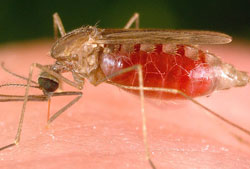In Malaria Fight, Enhanced Fungus Shows Promise

In the fight against malaria, our enemy's enemy – a fungus that infects and kills disease-spreading mosquitoes – has now shown promise as an ally.
Now, by adding new, malaria-fighting genes to that fungus, researchers say they have devised a potentially effective technique to staunch the spread of a disease that killed nearly 1 million people in 2008 — mostly African children — according to estimates from the World Health Organization.
The mosquitoes that spread the malaria parasite to humans with their bites are becoming resistant to the insecticides (a group of chemicals called pyrethroids) currently used against them, creating a need for new techniques for controlling the spread, the researchers said, writing in the Feb. 25 issue of the journal Science.
Some scientists have turned to fungi, such as Metarhizium anisopliae, that naturally infect, and ultimately kill, the mosquitoes. Because the fungus can penetrate and attack through the insects' shell, called a cuticle, it can be sprayed on surfaces both indoors and out. It is also effective against pesticide-resistant mosquitoes and can be used alongside insecticides.
But it has limitations. The timing of the fungal infection must be just right to prevent the spread of the parasite.
The fungus should not be altered to kill the mosquitoes more quickly, according to the researchers. The fungus doesn't kill an infected mosquito until after the mosquito has lived long enough to breed, so, the mosquito has little reason to evolve genetic resistance and pass on that ability. Shortening the time to death would create a selective pressure that would encourage the mosquitoes to develop resistance, as they have to insecticides.
Instead, the researchers beefed up the fungus with genes to fight the malaria parasite. They created strains of the fungus with genes that code for a chemical that prevents the malaria parasite from entering the insect's salivary glands (and so preventing it from being transmitted by a bite). They also added an antimicrobial protein normally created by scorpions that attacks the malaria parasite, as well as a human antibody specific to the malaria parasite.
Get the world’s most fascinating discoveries delivered straight to your inbox.
In the right combination, these additions cleared out as much as 98 percent of the malaria parasite from mosquitoes in the lab. Adding these genes meant that the timing of the mosquitoes' infection by the fungus was no longer so important, said study researcher Raymond St. Leger, a professor in the entomology department of the University of Maryland.
The fungus offers an easily managed model for testing and delivering other parasite-fighting proteins, an important means to help prevent the malaria parasite itself from becoming resistant, St. Leger and the authors write. The research team was led by Weiguo Fang, also of the University of Maryland's entomology department.



